Asus ROG Strix Scar G733 Review
The gaming laptop market has grown and changed dramatically over the by few years: machines have become more powerful and expensive while also getting sleeker and slimmer. The latest Asus ROG Strix Scar 17 gleefully pushes back against this trend for maturity. It'southward unashamedly a gaming laptop, with all of the gregarious blueprint yous'd expect, and it locks and loads some of the laptop earth's most powerful hardware, too.
Graphical grunt comes from the GeForce RTX 3080 with 6,144 CUDA cores and 16GB of retention, and we're e'er pleased to see an AMD Ryzen 9 5900HX – in previous tests, it's been the well-nigh powerful laptop processor money can purchase. Elsewhere, the Asus serves upward a 360Hz brandish and loads of RGB LEDs.
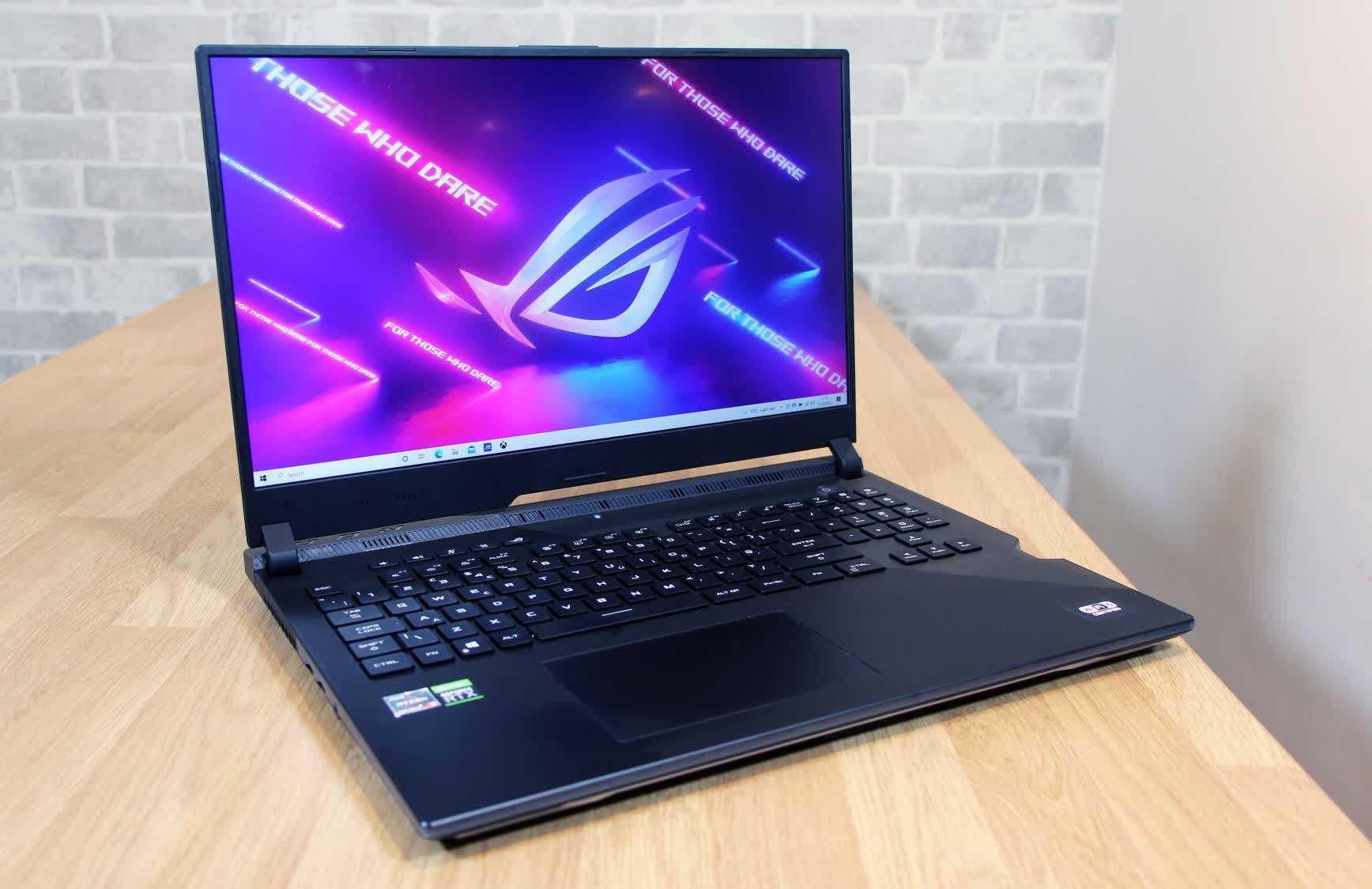
This kind of gaming hardware doesn't come up cheap, though – the ROG Strix model nosotros tested costs a whopping $two,999. And when you're packing this sort of power inside a notebook, there are plenty of other considerations, also, similar thermal functioning and battery life.
Features and Pattern
The beginning affair you'll notice about the ROG Strix Scar is the abundance of RGB LEDs. As with previous models, the forepart edge has a six-zone band of lighting, and the keyboard has per-primal RGB backlighting. New for this year is a two-zone low-cal that sits on the underside of the display. Information technology'south i of the most surprising RGB LED installations we've seen on a gaming laptop, and it helps the Asus stand up out.
Elsewhere, the Scar continues the extravagance. 1 side of the chapeau has a chrome-effect logo with more RGB LEDs, and the other has a dotted design that spells out ROG if y'all view it from the correct angle. A large swathe of the base of operations uses translucent plastic so that you lot can see the blurred excursion boards and metal beneath. A panel of that same plastic covers one end of the hinge, and Asus includes a couple of replacement panels in chrome and black plastic.
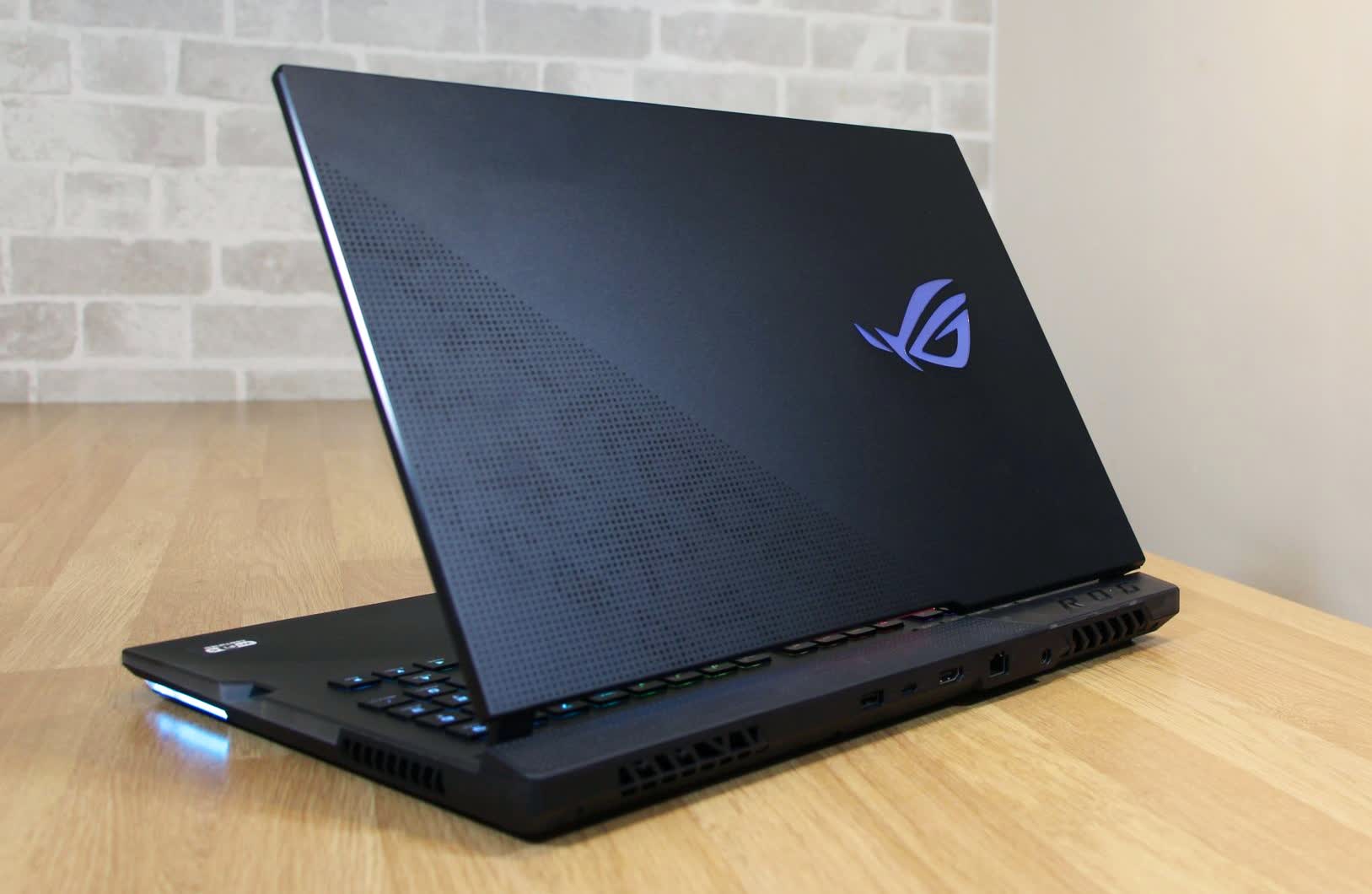
The Asus looks like a classic gaming laptop, only in other areas, the Scar likewise adheres to that familiar blueprint – for better and for worse.
Positively, information technology's got slim screen bezels and a reasonable amount of internal access. Use a Phillips screwdriver to remove the base, and you'll find two M.2 connectors and ii memory slots, although your configuration will affect how much is vacant.
Negatively, the Scar weighs near vi pounds and is 27.5mm thick, and then information technology's a big bruiser of a car – rival 17.3" notebooks are usually slimmer. The metal around the keyboard is a bit of a fingerprint magnet, as well. Build quality is a bit inconsistent: the display is robust, but there's movement in the keyboard deck, and it'south pretty easy to flex the base from underneath. The Asus is potent enough to withstand frequent travel in a backpack and life around the firm, merely it'southward not flawless.
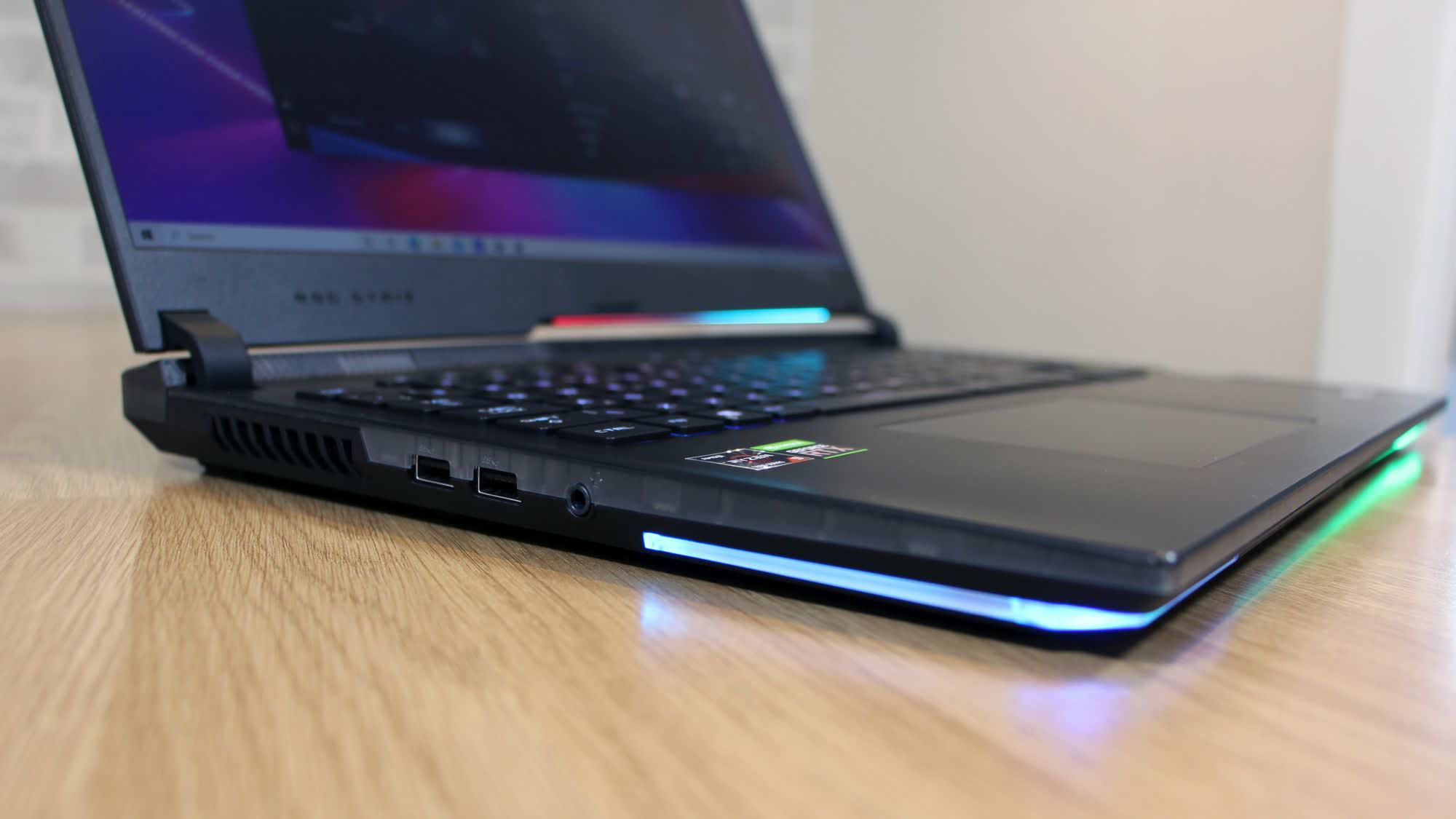
The range of features can be a bit mixed, too. On the left-mitt side, yous've got two USB iii.2 Gen one ports and a headphone jack, and on the rear, it's got another total-size USB connector alongside a USB three.2 Gen ii Type-C port that supports DisplayPort and 100W of power delivery. There's an HDMI ii.0b output here, too, but that version of the connector doesn't support 8K outputs.
That'due south information technology for connectivity, though – the Scar doesn't take a webcam, a carte reader, or a fingerprint reader, and in that location are no faster USB ports. The Scar's AMD chipset as well means no support for Thunderbolt. Asus' website says that this laptop includes an external 1080p webcam, but our sample didn't take one and retail sites don't list them.
The only feature on the right-mitt side of the organization is the Asus Keystone 2 slot. It'south a notch that holds a small RFID device chosen a Keystone. When plugged in, the Keystone can actuate personalized settings, launch a customized set up of applications or settings, or trigger an encrypted storage bulldoze. It's a scrap of a gimmick.
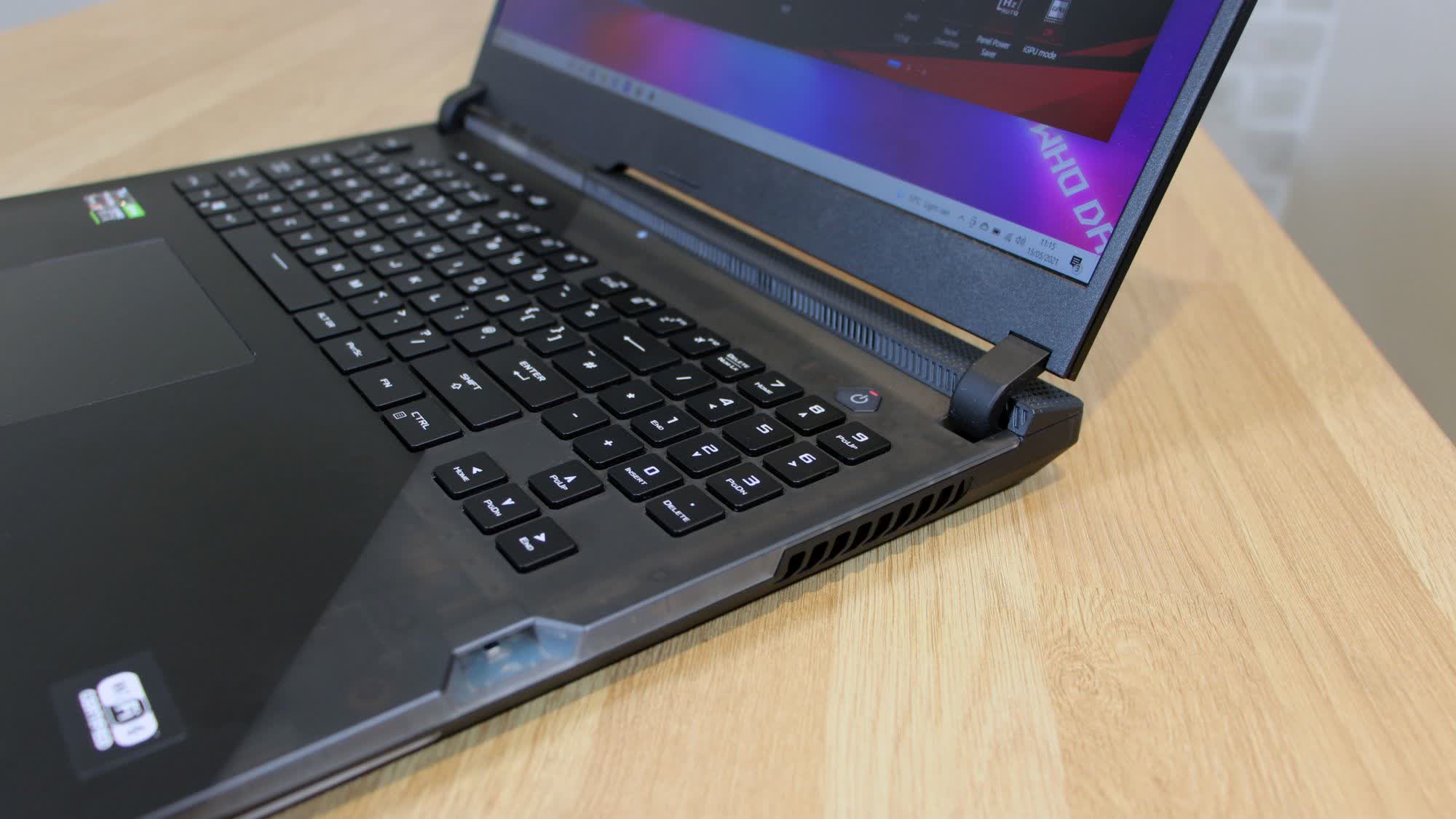
This twelvemonth'due south Scar has a new keyboard. It'due south one of the few laptops with opto-mechanical switches, and the buttons have a decent one.9mm of travel and a 0.2ms response fourth dimension with nada debounce delay. The layout is decent, with actress buttons for altering the speaker volume and fan speeds, and opening the Asus Armoury Crate app, and it's got full-size cursor keys and a number pad. The only quibble is that the number pad is shorter, which ways at that place are no dedicated PgUp, PgDn, Habitation, or Delete buttons.
The keyboard is splendid: incredibly fast, with a clicky, bouncy feel. These buttons quicker and sturdier than any y'all'll find on a chiclet unit, and this is ane of the best keyboards you'll discover on whatever gaming notebook at the moment.
The keyboard is louder, too, so a conventional chiclet keyboard volition exist better if you adopt a device with a softer feel beneath the fingers.
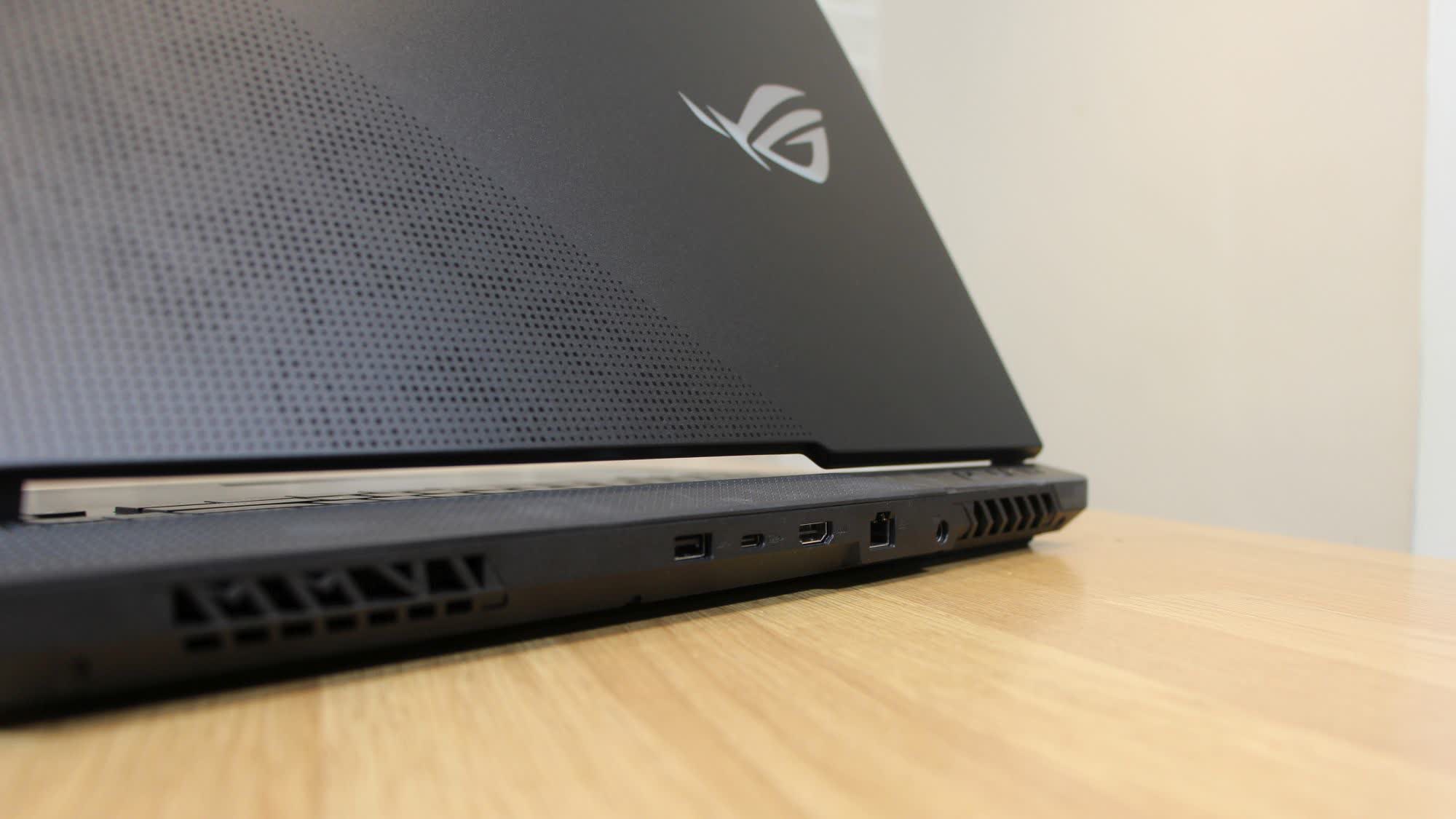
The trackpad is large and polish, only anyone serious almost gaming should connect a proper mouse instead. The buttons take moderate speed, but their clicking action is slower and spongier than a decent mouse. The pad is on the car's left, so it's too piece of cake to accidentally trigger while using the keyboard.
Sitting above the keyboard is the stunning 17.3" display. The model nosotros've reviewed uses a 1080p IPS panel with a 360Hz refresh rate, adaptive sync, and a 3ms response time. That'south the sort of specification that volition tackle any gaming scenario.
Truthful to form, the Scar's console scythed through whatever job, with butter-smoothen gaming in fast-paced esports titles and high-quality unmarried-player experiences.

It has impressive quality levels. The brightness level of 319cd/m2 combines with a blackness bespeak of 0.24cd/m2 to serve upwards a contrast ratio of 1,329:1, which is rock-solid for an IPS panel – information technology means you're getting impressive depth and nuance without oversaturated colors.
The Asus display besides has a fantastic Delta E of 1.25 and a color temperature of 6,476K. They're both superb, and they ensure that colors display accurately. The screen is consistent, likewise: uniformity tests illustrated that the panel but lost effectually five% of its backlight force in most sectors, so images won't be distorted. The Scar's panel rendered 97.6% of the sRGB gamut at 102.ane% volume, so it'll return about every shade you need without oversaturation.
The brandish only has minor problems. Its effulgence level is good enough for indoor play merely isn't high enough to handle outdoor gaming or work. It likewise can't return the Adobe RGB or DCI-P3 gamuts, then HDR gaming and certain color-sensitive workloads aren't feasible hither.
The speakers are superb, with impressive bass, mid-range clarity, and high-stop tones that are vibrant without being tinny. At that place's good remainder and depth from the pairs of 4W speakers and 2W tweeters, and this audio kit is easily proficient enough for gaming and media – and far ameliorate than most laptop audio hardware.
Functioning
This car'southward RTX 3080 uses the usual vi,144 CUDA cores and the fantastic Ampere architecture, and Asus has deployed the beefier version of the menu with 16GB of GDDR6 retentiveness that runs at fourteen Gbps. We covered this GPU in better detail in our review, but in improver to all the generational upgrades we've discussed, you will want to know Asus is running the RTX 3080 in this laptop at power consumption levels between 115W and 130W, with Dynamic Boost 2.0 delivering the latter. Those are hefty figures, although the RTX 3080 laptop core can theoretically acme at 165W.
The high-cease graphics hardware sits aslope an AMD Ryzen 9 5900HX. It's a stunning laptop chip sporting an 8-core/16-thread design and Zen 3 architecture, and information technology has theoretical base and boost speeds of 3.3GHz and four.6GHz.
The specification rounds out with 32GB of dual-aqueduct 3,200MHz DDR4 and a RAID 0 array that uses two 1TB Samsung PM981 SSDs. You get ane.84TB of formatted infinite aslope superb read and write speeds of 6,964 MB/s and 5,650 MB/s, which is excellent for content-creation and quick loading times – but RAID 0 means no information redundancy.
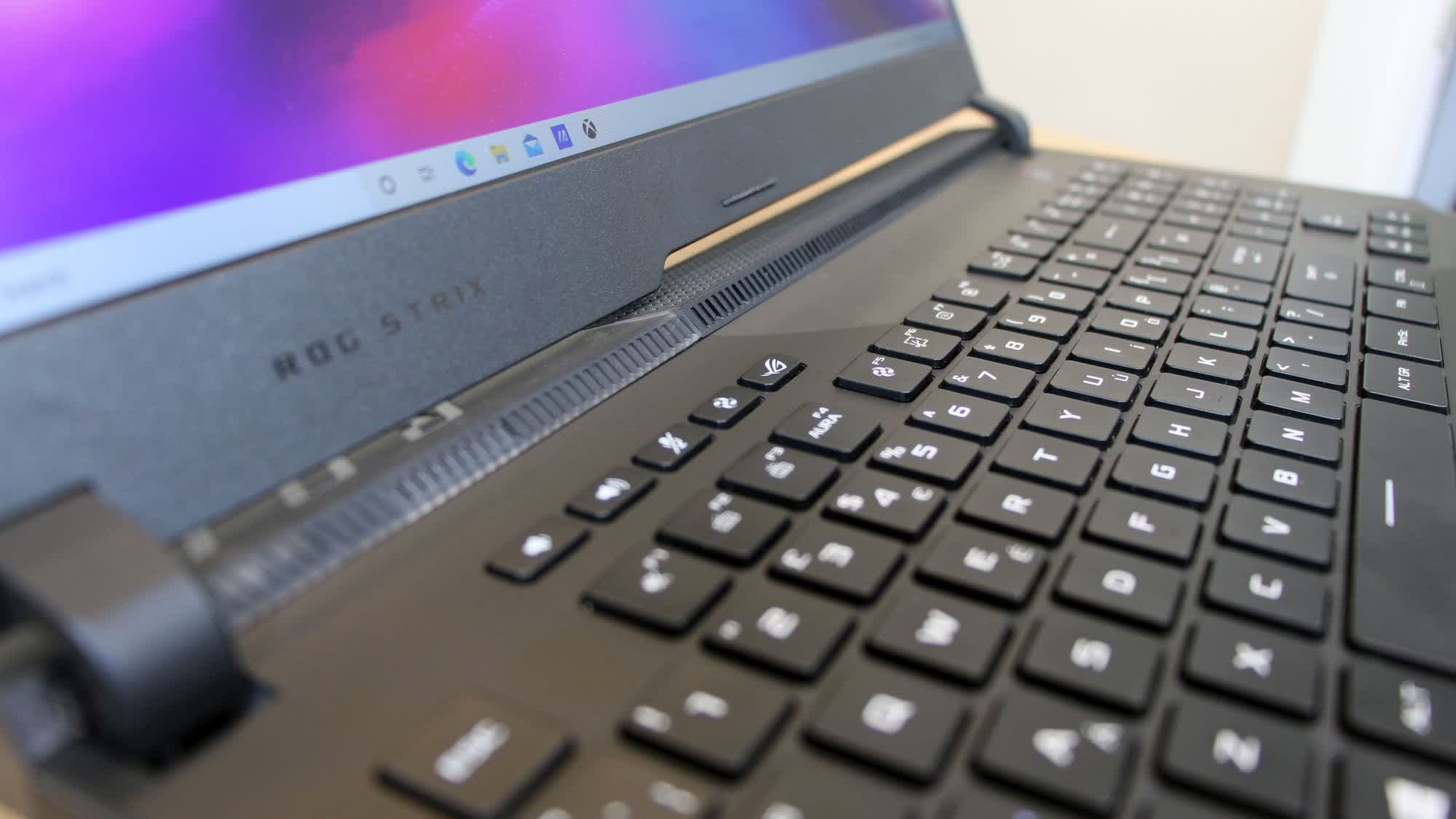
Connectivity comes from dual-ring 802.11ax wireless, Bluetooth 5.one, and Gigabit Ethernet. It's disappointing that at that place's no 2.5Gbps or 10Gbps Ethernet on this machine. This specification is the same equally the Asus Zephyrus Duo GX551 that we reviewed in February. Asus clearly doesn't want to mess as well much with a good matter.
If you lot'd similar a more in-depth wait at the cadre components, then yous're in luck: we've already covered the Ryzen 9 5900HX and GeForce RTX 3080 Laptop core in separate defended reviews.
The Scar's RTX 3080 is impressive. In Assassinator's Creed Valhalla it averaged 76.iii fps, and information technology hammered through Far Cry New Dawn at 94.9 fps. In Red Dead Redemption 2 it averaged 93.9 fps, and in Shadow of the Tomb Raider it scored a superb 111.5 fps and then striking 85.9 fps with ray tracing activated. In Rainbow Six Siege at medium settings and 1080p the GPU delivered an boilerplate of 235 fps.
| Game Benchmarked | 1080p Ultra settings (min / average FPS) |
| Far Cry New Dawn | 72.4 / 94.9 |
| GTA V | 81.9 / 116.8 |
| Shadow of the Tomb Raider | 77.ane / 111.5 |
| Red Dead Redemption 2 | 61.3 / 93.9 |
| Assassin's Creed Valhalla | 53.half-dozen / 76.3 |
| Borderlands iii | 62.six / 92.3 |
Those are tremendous results, significant at 1080p this laptop will play anything, including ray-traced titles. There'due south enough power to play tough single-player games at framerates beyond 60 fps consistently. We recorded frame rates faster than 60fps when we ramped these games to their well-nigh challenging graphics settings, too, so you lot've got loads of future headroom.
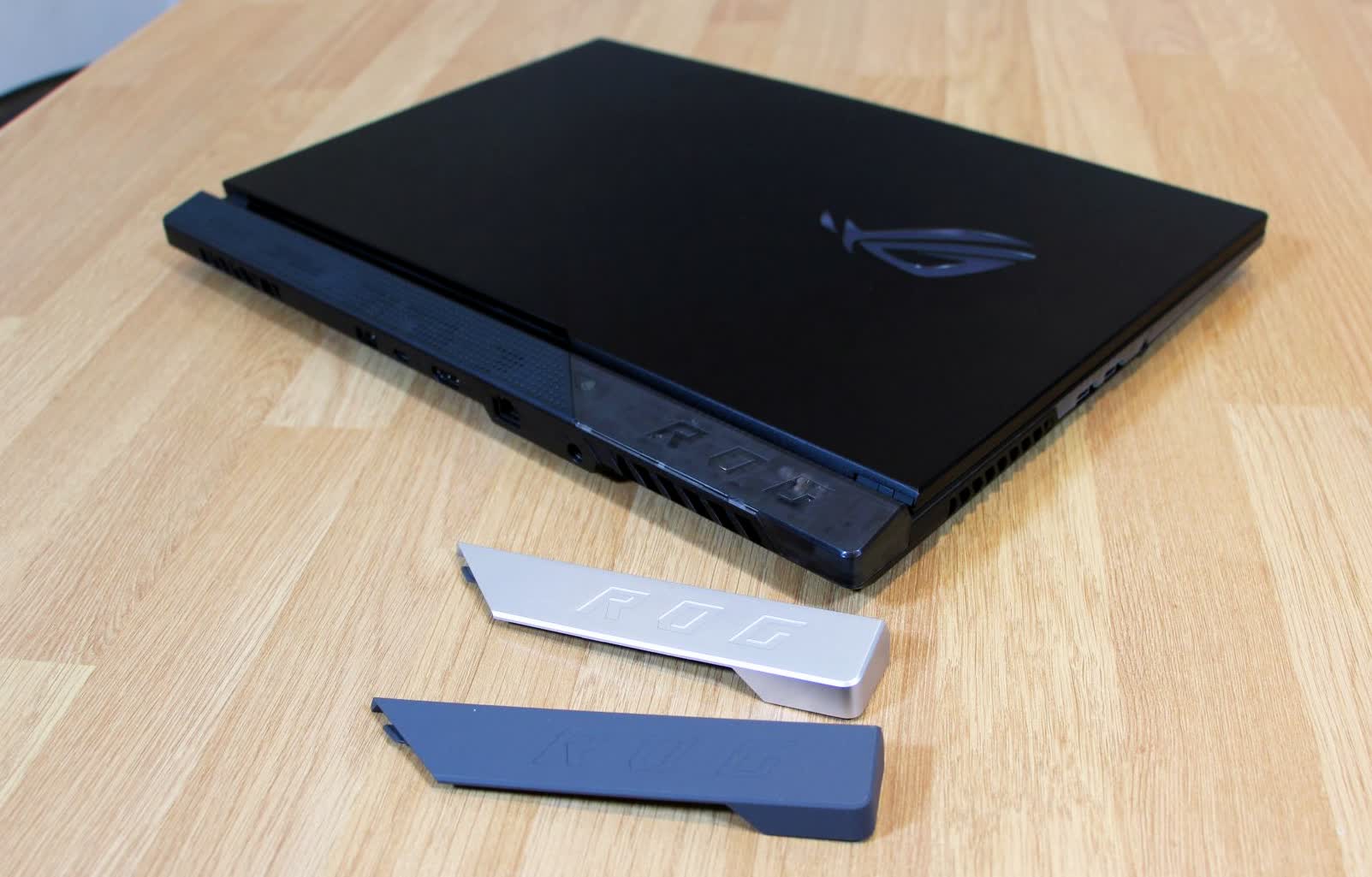
The RTX 3080 can also handle esports games at the frame rates required by the 360Hz display, especially if you lot're willing to drib some of the eye candy. If you desire to output to VR headsets and 4K screens, this laptop can tackle that, as well, but y'all may have to drop GPU settings a little to ensure consistently smooth performance.
Unsurprisingly, at that place'southward little between this Asus and the dual-screen machine we reviewed earlier in the year: the Scar is a little quicker, no doubt thanks to driver updates and software improvements. The RTX 3080 in our in-depth review was marginally faster than this laptop, just the MSI auto in that article ran its RTX 3080 at TDPs between 135W and 155W. And, finally, don't expect the laptop RTX 3080 to match the desktop menu – the laptop GPU is effectually 25% slower on average.
All of the scores we've mentioned so far used the Asus' Performance Mode power setting, which is the motorcar's default option. As with well-nigh Asus gaming notebooks, you've also got Windows, Silent, and Turbo options to deploy.
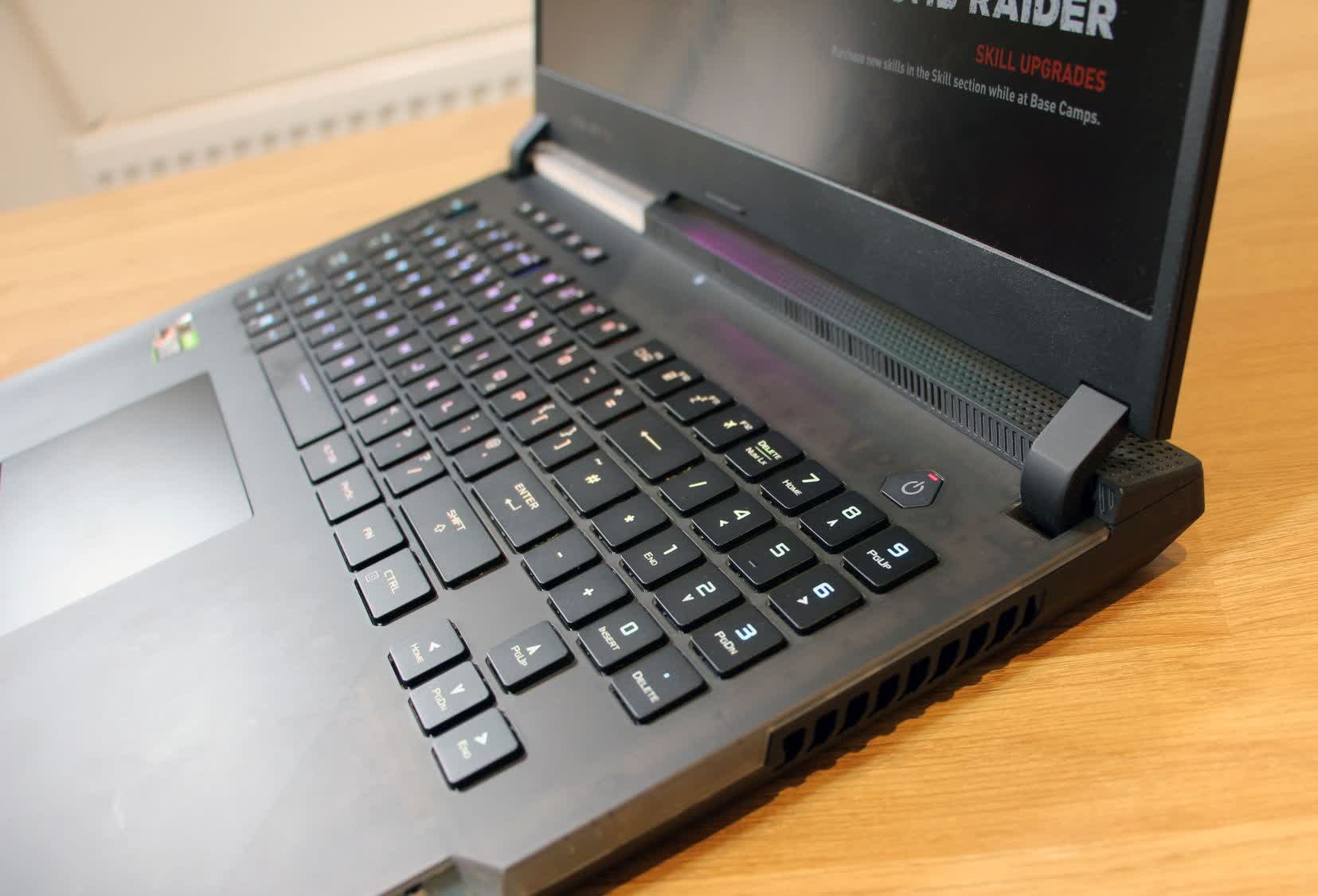
In Performance Way, the GPU runs at effectually ane,400 MHz. Activating Turbo Mode increases that speed to around 1,500 MHz when gaming. In real-world terms, that tiny speed boost doesn't translate to much actress functioning – the laptop was a couple of frames faster in a couple of games, but that'due south it. The Windows selection dropped the GPU speed to merely beneath 1,400 MHz, which reduced speeds past a couple of frames.
The most interesting option is Silent Mode, which sees the GPU peak at around i,100 MHz during gameplay. And while the Asus isn't perfectly repose, it does make hardly any racket – it's extremely placidity. Impressively, across our gaming tests in Silent Mode the Asus ran at a smooth 60 fps, which ways you can play single-histrion games at a rock-solid framerate with hardly any noise. For slick, well-counterbalanced gameplay, this is an excellent choice.
When running games in Functioning Mode, the Scar's produced 45db of fan noise. That'due south non awful – no louder than other gaming notebooks, a little quieter than the GX551, and soft plenty that the speakers or a headset will drown it out. In Turbo Mode the noise level rose to an irritating 58db. Speakers or a headset will notwithstanding take care of that, but information technology's a hefty increment for a relatively pocket-sized frame rate heave. We liked how the Asus behaved in Silent Mode: its acme noise level of 32db when gaming is barely audible.
We got no issues with GPU temperatures, either – in the about enervating benchmarks, the graphics cadre peaked at 85 degrees, which is manageable.

The processor of selection here is great for content-creation, creative work, and multi-tasking. Information technology's brilliant in single-threaded tasks, too, and consistently outpaces Intel's silicon while offering a small lead over more affordable laptops with the Ryzen 7 5800H.
The 5900HX in the Asus wasn't quite as quick as the chip in the XMG laptop that we used in our CPU review. In Cinebench R20'southward unmarried- and multi-core tests, the Asus returned results of 559 and 4,824 – both are marginally behind that CPU and a little ahead of the 5800H. It was a piffling slower than the reviewed CPU in Blender with an overall upshot of four minutes and xix seconds, and in the seven-Zip compression and decompression tests it delivered speeds of 48.72MB/south and 689.02MB/south, with both results a few megabytes behind the XMG.
In PCMark ten's awarding exam, the Asus scored 14,055, which was marginally better than the reviewed 5900X and 5800H, merely the Scar's Essentials score of x,412 was slower than both, albeit past a slim altitude. In the high-end Matlab R2020 benchmark the Scar scored 1.31. That'southward a footling backside the XMG-based 5900HX and on par with the 5800H.
This may non be the best implementation of the Ryzen ix 5900HX, simply it'south withal a nifty chip, and it all the same beats anything that Intel can offer until we've been able to test the firm's new 11th-gen functioning CPUs.
Clock speeds explain the slight performance disparity. In the Scar'south default Functioning Way, the CPU peaked at 4.5GHz in unmarried-threaded tasks and 4.2GHz in multi-core benchmarks, with the former figure a lilliputian slower than the CPU's theoretical speed. Activating Turbo Mode saw the Asus draw level with our 5900HX in multi-core tests, but didn't make much difference to unmarried-core performance.
Silent Manner saw the CPU peak 2.8GHz, which does bear upon operation – its Cinebench result dropped to 4,049. But if you're handling everyday workloads, that'southward enough. The Windows choice acted equally a halfway house betwixt the Silent and Operation Modes, with the CPU peaking at 4GHz.
When running piece of work benchmarks in Performance Mode, the Scar's audio level of 39db is decent and easily manageable, and it was serenity in Silent Manner. In Turbo Manner and when running work benchmarks, the Asus ramped upward to around 55db, which is extremely loud. And, in Turbo Style, the CPU's temperature peaked at a toasty 95°C.

With CPU temperatures kept below 90°C and the dissonance levels more manageable in every other performance option, the Turbo Style isn't actually worth it. As with our gaming tests, it delivers a tiny benefit alongside loads of extra noise and estrus.
Happily, the Asus' exterior remained pretty cool no matter the benchmarks or the operation option. The base console and the area to a higher place the keyboard only warmed upward a little, and only a tiny fleck of warm air vented from the sides. On the outside, it's a better neb of wellness than most gaming laptops.
And, equally usual, don't wait much battery life from this gaming notebook. When you're gaming, no matter what you lot practise with the performance modes and the effulgence level, you're non going to get more than 90 minutes from this machine – and GPU performance is restricted when using the battery.
If you button the hardware while working, the Asus lasts for nether three hours. At best, nosotros got betwixt vi and 7 hours of longevity from this laptop, just that was when the machine tackled low-terminate tasks, similar spider web browsing and running Part tools.
The Asus we've reviewed is the elevation-end model. Happily, more affordable specifications are likewise bachelor. The $ii,199 version of this organisation drops downward to an RTX 3070 and halves the SSD size, and uses a brandish with a 2,560 x i,440 resolution and a 165Hz refresh charge per unit, and then it's crisper. At that place'southward a $2,699 machine, too, that pairs the 1440p screen with an RTX 3080. All of these use the Ryzen ix 5900HX.
Yous tin can also become a motorcar with the 1440p display and RTX 3080 or 3060 within a 15.vi" torso starting at $i,599 if you'd like something smaller. Just search for the G533 rather than the G733.
Who Is It For?
Information technology feels like lots of the game laptops you can buy right at present are well-nigh ashamed of themselves – they attempt to cram high-end hardware within designs that look more suited to the boardroom.
This latest Asus ROG Strix Scar 17" isn't similar that. This auto embraces its gaming origins, with loads of RGB LEDs and logos, and it backs upwards the assuming design with impressive performance in key areas.
The RTX 3080 will handle any gaming task at 1080p: it's got the grunt for acme, ray-traced single-player games alongside that smart Silent Mode that targets 60fps performance, and it'll run any esports title at appropriate speeds. The AMD processor doesn't quite perform at tiptop speed, merely information technology'due south still exceptionally quick and can take on tough content-creation tasks.
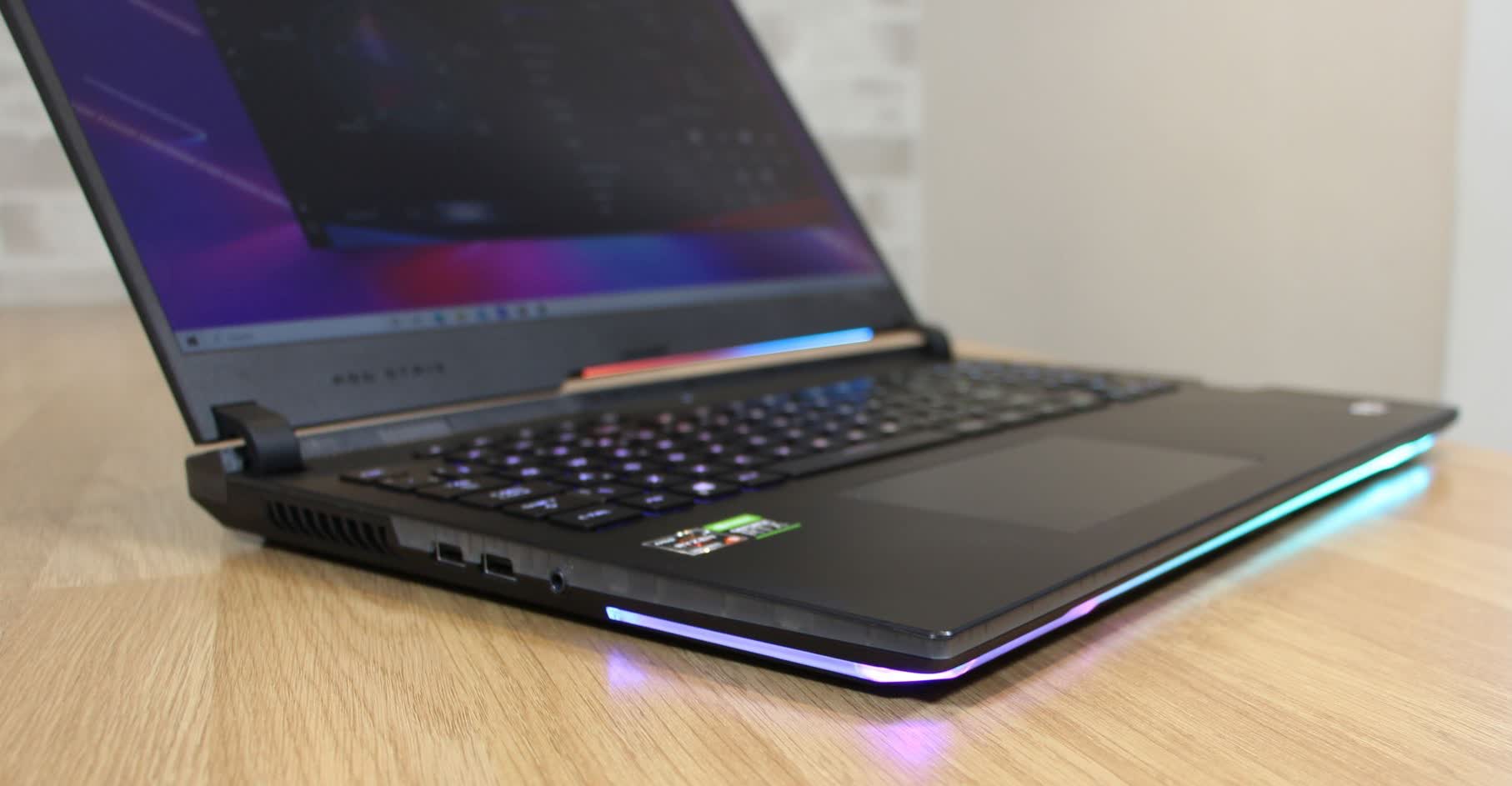
The display makes games await fantastic, the speakers are great, the opto-mechanical keyboard is snappy and robust, and the RAID array is quick. The Asus is a decent thermal performer, too – in that location are occasional instances where it'due south notably loud or hot, but those are rare. For the virtually part, the G733 is cooler and quieter than its predecessors and other laptops in its course.
Of course, there are certain areas where this gaming laptop – like many others – falters. Battery life isn't great, but gaming laptops never have much to offer in that section. The Asus misses out on features like a webcam, card reader, and fingerprint reader. The screen tin can't display HDR or Adobe RGB content, the trackpad is just average, and the Asus is reasonably sturdy, but thick and heavy, also. And, of course, this loftier-end machine does non come cheap.
The bug and compromises hateful that the Asus won't adjust anybody, particularly if y'all demand a machine for piece of work as well as play. But if you desire a large notebook that absolutely nails gaming, then the latest ROG Strix Scar 17 fits the bill – it'southward bold, fast, and powerful.
Shopping Shortcuts
- Asus ROG Strix G733 (RTX 3080) at Amazon, Best Buy
Source: https://www.techspot.com/news/89854-asus-rog-strix-scar-g733-review-rtx-3080.html
Posted by: cookgrencir1939.blogspot.com


0 Response to "Asus ROG Strix Scar G733 Review"
Post a Comment